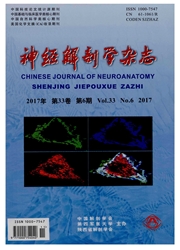

 中文摘要:
中文摘要:
目的观察不同低氧浓度环境对大鼠海马齿状回神经发生的影响。方法:取健康雄性Sprague—Dawley(SD)大鼠60只,随机分为11%和15%氧浓度干预组,分别包括常氧对照组(C11,C15),低氧4 h组(4H11,4H15)和低氧8 h组(8H11,8H15)。对所有组大鼠的脑组织切片进行BrdU和NeuN免疫荧光染色,计数海马齿状回内新生细胞数量和新生神经元数量。结果:(1)同一氧浓度组间比较:各组大鼠海马齿状回新生细胞数量(BrdU+)、新生神经元数量(BrdU+/NeuN+)以及新生神经元占新生细胞数量的百分比(Pneuron)均无显著性差异。(2)不同氧浓度、相同低氧干预时间比较:C11和C15,4H11和4H15以及8H11和8H15的BrdU+、BrdU+/NeuN+和Pneuron均无显著性差异。结论:在11%或15%氧浓度环境中,每天进行4 h和8 h的低氧干预,连续7d,对大鼠海马齿状回新生细胞的数量和新生细胞的分化无明显调节作用。
 英文摘要:
英文摘要:
Objective This paper aimed to observe and analyze the influence of different hypoxia interference on neuro-genesis in dentate gyrus (DG) of the hippocampus in young rats. Methods: 60 male SD rats were randomly assigned intocontrol groups (C11, C15 ) and hypoxia treatment groups. According to different hypoxia exposure times (4, 8 h/d) andoxygen concentration (11% , 15% ) , hypoxia treatment groups were divided (4H11, 4H15, 8H11, 8H15 ). The DG inrats was detected by an immunofluorescence technique which labeled BrdU and NeuN. Results: ( 1 ) Intergroup comparison in the same oxygen concentration, there were no differences in the number of the BrdU positive cells ( BrdU + ), thenumber of the BrdU and NeuN double positive cells ( BrdU +/NeuN + ) and the percentage of new neurons in regenerativecells (Pneuron) between C11,4H11 and 8H11. (2)Different oxygen concentration, but the same hypoxia exposure timecomparison, there was no difference between 11% oxygen concentration groups and 15% oxygen concentration groups inthe number of BrdU+ , BrdU+/NeuN+ and Pneuron between 4H11 and 4H15,8H11 and 8H15. Conclusion: There areno impact of 7 days of 11% oxygen concentration hypoxic and 15% oxygen concentration hypoxic exposure for 4 h/d and8 h/d on promoting the neurogenesis in dentate gyrus of rats.
 同期刊论文项目
同期刊论文项目
 同项目期刊论文
同项目期刊论文
 期刊信息
期刊信息
